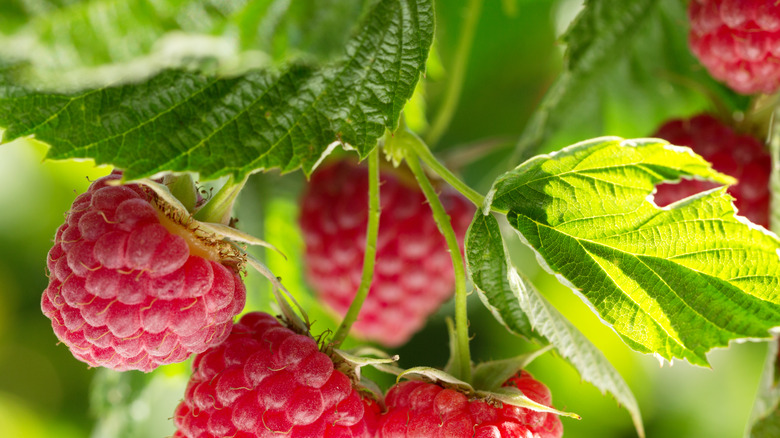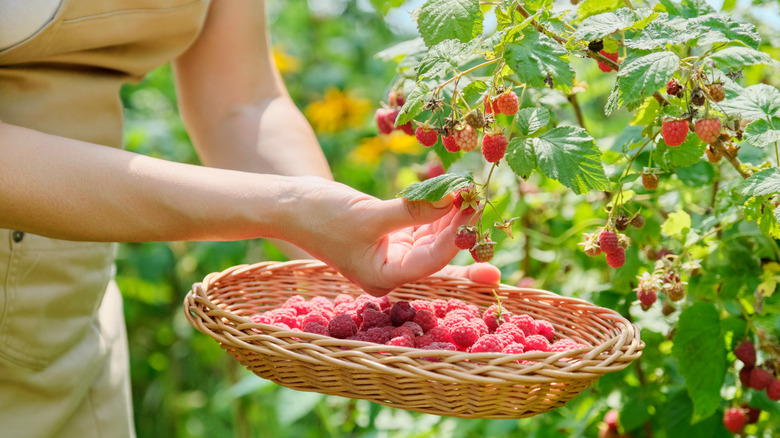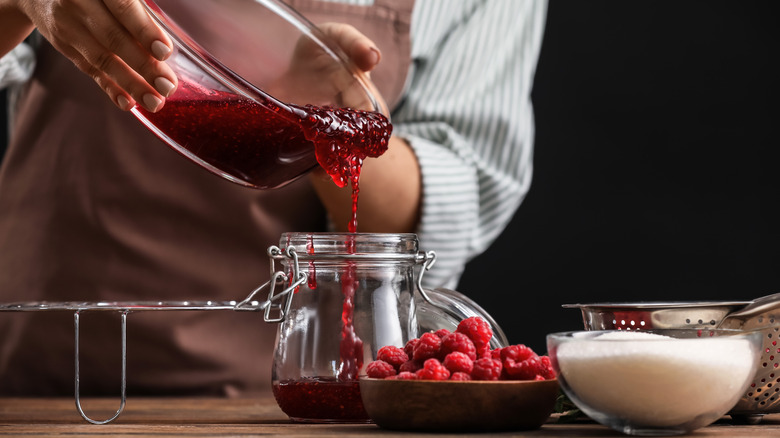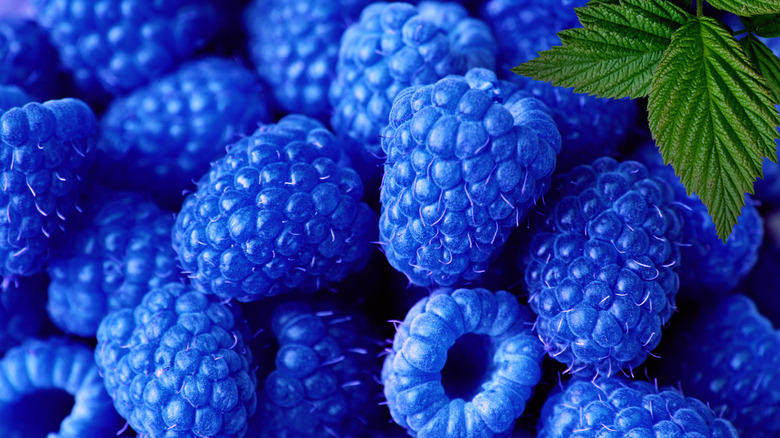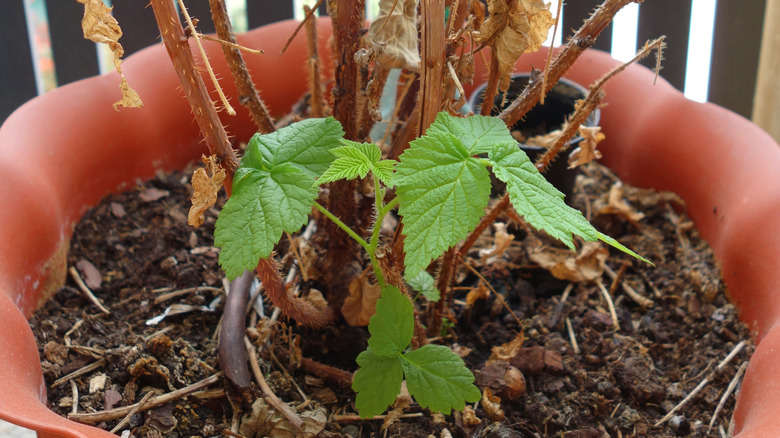How To Grow And Care For A Raspberry Plant
Raspberries are so ubiquitous that there's a color named after them — and even Prince couldn't resist paying homage to the fuzzy little delicacy in his 1985 hit, "Raspberry Beret," per IMDb. Raspberries (Rubus idaeus) are brambles and part of the 3,500 species of plants that are part of the rose family. They're deciduous, and like blackberries, they're a climbing shrub.
These perennials grow canes that live for two years. They can also bear fruit twice annually, yielding hundreds of berries each year. You'll see them across a spectrum of colors, including yellow, gold, purple and black, and their familiar candy apple red. Although insects like bumblebees and even a gentle wind can help the plant spread, raspberry bushes self-pollinate and often thrive in the wild without intervention.
Raspberries are used in smoothies, liqueurs, baked goods, preserves, and sorbets. As anyone who's ever tasted one knows, each of the little aggregates of drupes that make up a raspberry is so full of flavor. Many people sprinkle them on top of cereals or add them to salads because they're so naturally sweet. While some individuals are sensitive to the natural chemicals they contain and have allergic reactions, raspberries are full of vitamin C and antioxidants.
Ask the experts at Permaculture, and they'll tell you that a raspberry bush can grow to about 6 feet in height. Many are instantly recognizable from their serrated leaves and stems that feature spine-covered rods.
Raspberries in your garden
Raspberries make an attractive addition to any garden with five-petaled flowers of pink or white before bearing fruit that can occasionally produce berries in the rare colors of purple, amber, orange, and pale yellow. Some of their plant canes are prickly, others smooth, and it's common for them to reach 6 feet high and produce fruit as soon as their second year. Raspberry plants can make quite a visual statement.
Encyclopedia Brittanica says that the most popular commercial raspberries are either hybrids or cultivars of the R. strigosus or R. idaeus varieties. Several black raspberry species native to North America, such as R. occidentalis and R. leucodermis, are often produced in smaller batches as specialty items.
If you're thinking of planting them outdoors, consider when you want to harvest the fruit. Some varieties bear fruit only once in the summer, and those are the most common. But the Old Farmer's Almanac points out that there are also ever-bearing bushes that can yield fruit in the fall and again when summer rolls around. They recommend having both since it means a longer period of having fresh raspberries on your table.
How to grow raspberries
The first step to take if you're considering growing your own raspberries is to assess your available space. In order to produce fruit, these plants require basking in the sun for no less than six to eight hours daily. You'll also want to make sure that their environment is on a plane that doesn't collect water and drains well because sitting in damp soil is a direct path to root rot for these plants.
Next, you'll need to determine whether you want the upright variety or you'd prefer vines. Some varieties produce thorns similar to blackberry plants, so be careful. Staking or using a trellis is essential for growing vines to avoid feeding any creature that wanders into your garden and is advisable even for the upright canes because bearing fruit can be strenuous. Raspberry plants prefer slightly acidic soil, and the experts at Old World Garden Farms say early spring planting is optimal, and it's best to get them into soil mixed with sand and compost. The compost provides nutrients, and the sand ensures you get good drainage at the outset.
Create a hole big enough for the plant's crown to nestle about an inch above ground (to ensure you won't have a soggy bramble) and backfill with equal parts of soil, sand and compost around your plant. Place the plants upright slightly more than a dozen inches apart. Vining plants can coexist with as little as half an inch between them.
How to care for raspberries
When it comes to keeping your raspberry plants happy and healthy, mulching is your ally. Straw is particularly good in this regard since it will inhibit weeds and will not allow moisture to accumulate around your bushes, per Old World Garden Farms.
First-year growth will require that you fertilize your plants twice, followed by a single dosing every year thereafter. Two or three pounds of NPK/10-10-10 fertilizer (depending on the size of your plant) is recommended by Home Guides, although some experts suggest that 20-20-20 works as well or better. The numbers and letters correspond to the ratio of Nitrogen (N), Phosphorus (P) and Potassium (K) in the fertilizer mix. These are general suggestions based on the average size of a plant, so if what you've put in a bed is larger or smaller, you'll want to adjust accordingly.
The other most important factor in getting the most from your plants is that they benefit greatly from pruning. The summer variety respond best to being pruned twice annually. Growing bushes will need a trim come springtime and immediately following your berry harvest. And, because ever-bearing bushes yield fruit twice a year, you should prune them after each time they produce berries.
Lastly, be careful with what you plant nearby because raspberry bushes are susceptible to funguses of plants close to them. It's best to keep them far from blackberry bushes and any soil that's been used to grow potatoes or tomatoes, per Harvest to Table.
Varieties of raspberries
There are more than 200 species of raspberries, and while they all taste like raspberries, you'll find a surprising diversity among them. And, as Home for the Harvest points out, you'll find that even the raspberries you grow will have different flavor profiles from year to year, depending on the weather and how they've been fertilized.
Like growing red and yellow bell peppers, having multi-colored berries before you is as much a treat for the eyes as the palate. Here are a few of the more popular varieties.
• Anne Raspberries are fruity in flavor, firm in texture, and appear in a light yellow. Some folks swear these taste somehow tropical. They're found on specific ever-bearing plants, so you'll see them in July with another larger crop just before fall.
• Bristol Raspberries do well in cooler climates. They're black and firm and have a flavor all their own. Fans of this variety enjoy them in preserves, and they grow without requiring stakes or trellises. They appear in July.
• Caroline Raspberries have just a little zip that makes them slightly tart. They bear fruit in mid-summer and again just before frost appears locally. They're also renowned for delivering a bountiful harvest of berries.
• Fall Gold Raspberries are at the sweeter and more tender end of the spectrum and appear in a very glorious shade of gold. They'll start to appear in July and keep pumping out berries on the newest canes until the first frost.
How to repot raspberries
Maybe you're an urban dweller with a patio garden, or perhaps you just want something smaller and more manageable. Either way, it is quite possible to grow raspberries without having unlimited acreage to let them roam free. You will have to meet your plant halfway, however. They won't take up your guest bedroom or take over your porch, but they need room and six to eight hours of sunlight a day. The gardeners at Harvest to Table suggest that the fall-bearing and shorter varieties will do better than others growing in containers. And anytime you're growing something with thorns, you should be aware of who might encounter it.
That said, most raspberry plants should be potted or repotted in the early spring before you see any signs of leaves appearing. You'll want a deep container that's about a dozen inches wide with decent drainage. Have potting soil (preferably organic) standing by, and plant no more than three canes in the same container. You should repot them again when they go dormant in the winter.
Pruning should also be a priority and conducted before the plant starts its second year. Failure to prune means container congestion, smaller fruit, or worse: no fruit at all. Young canes do best if they're pruned to between 4 and 5 feet tall.
